Analysis of External & Internal Factors Impacting MNEs' IHRM
VerifiedAdded on 2021/09/27
|12
|3607
|38
Report
AI Summary
This report delves into the critical factors impacting International Human Resource Management (IHRM) within Multinational Enterprises (MNEs). It meticulously examines the influence of both external and internal elements on staffing choices and overall HR strategies. The external factors explored encompass political and legal landscapes, economic conditions, socio-cultural norms, and technological advancements, highlighting their profound effect on MNEs' operations across different global regions. The report further investigates internal factors such as organizational strategy, company culture, trade union dynamics, and financial capabilities, demonstrating their significant role in shaping HR decisions. Through a comprehensive analysis, the report provides valuable insights into the complexities of IHRM, emphasizing the need for MNEs to adapt their strategies to navigate the diverse and dynamic global environment effectively. This detailed assessment is essential for understanding the multifaceted challenges and opportunities in managing human resources on an international scale.
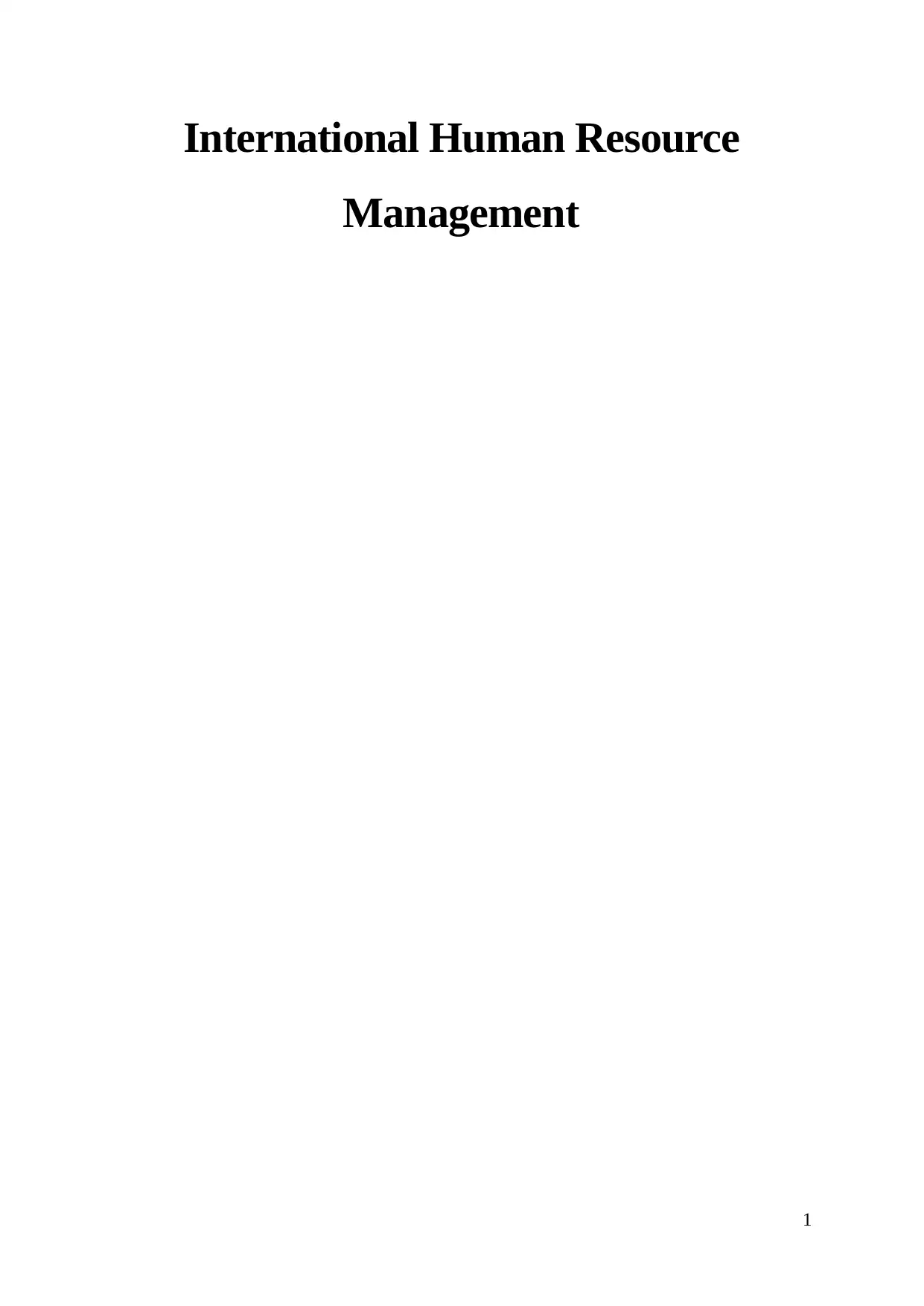
International Human Resource
Management
1
Management
1
Paraphrase This Document
Need a fresh take? Get an instant paraphrase of this document with our AI Paraphraser
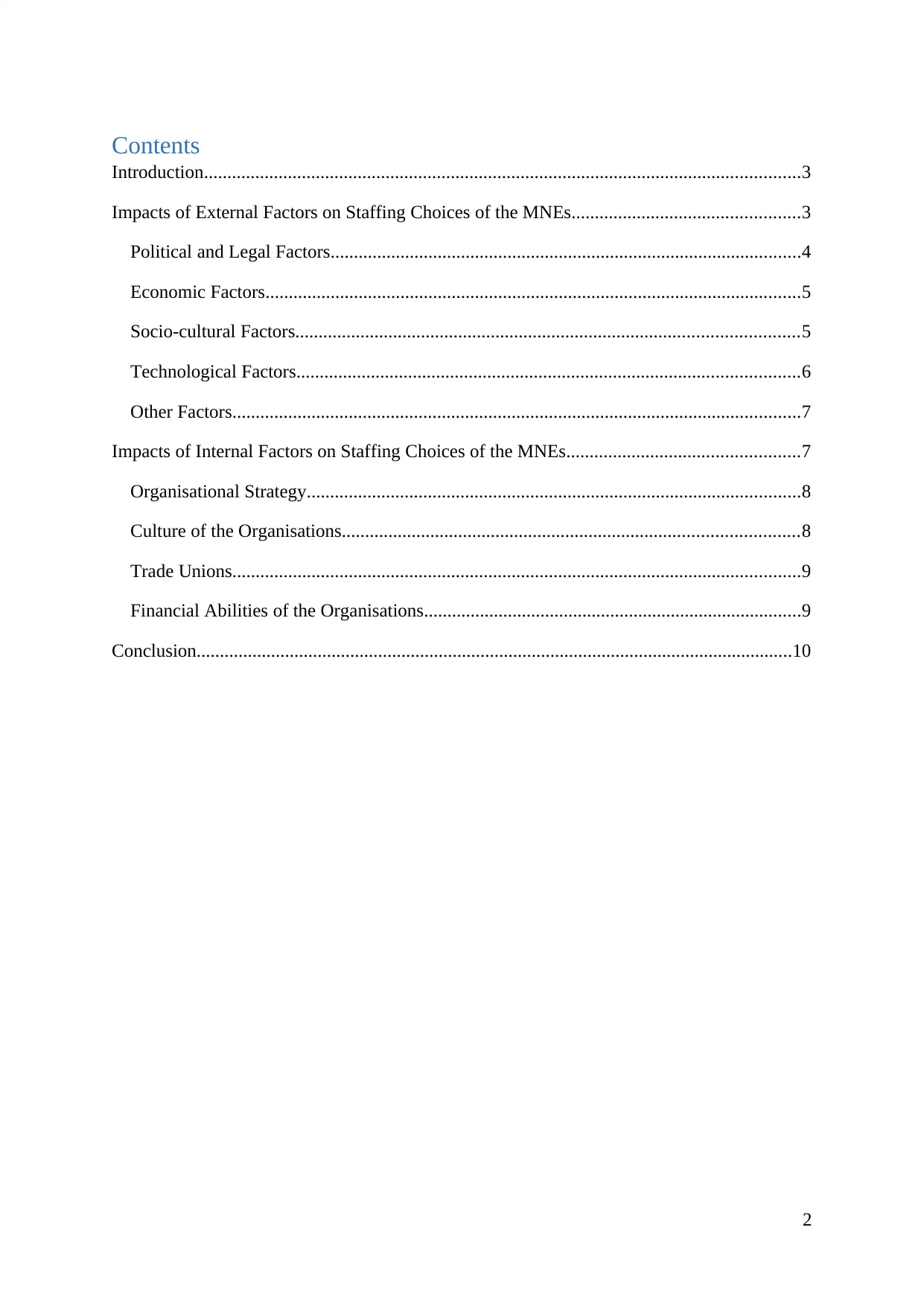
Contents
Introduction................................................................................................................................3
Impacts of External Factors on Staffing Choices of the MNEs.................................................3
Political and Legal Factors.....................................................................................................4
Economic Factors...................................................................................................................5
Socio-cultural Factors............................................................................................................5
Technological Factors............................................................................................................6
Other Factors..........................................................................................................................7
Impacts of Internal Factors on Staffing Choices of the MNEs..................................................7
Organisational Strategy..........................................................................................................8
Culture of the Organisations..................................................................................................8
Trade Unions..........................................................................................................................9
Financial Abilities of the Organisations.................................................................................9
Conclusion................................................................................................................................10
2
Introduction................................................................................................................................3
Impacts of External Factors on Staffing Choices of the MNEs.................................................3
Political and Legal Factors.....................................................................................................4
Economic Factors...................................................................................................................5
Socio-cultural Factors............................................................................................................5
Technological Factors............................................................................................................6
Other Factors..........................................................................................................................7
Impacts of Internal Factors on Staffing Choices of the MNEs..................................................7
Organisational Strategy..........................................................................................................8
Culture of the Organisations..................................................................................................8
Trade Unions..........................................................................................................................9
Financial Abilities of the Organisations.................................................................................9
Conclusion................................................................................................................................10
2
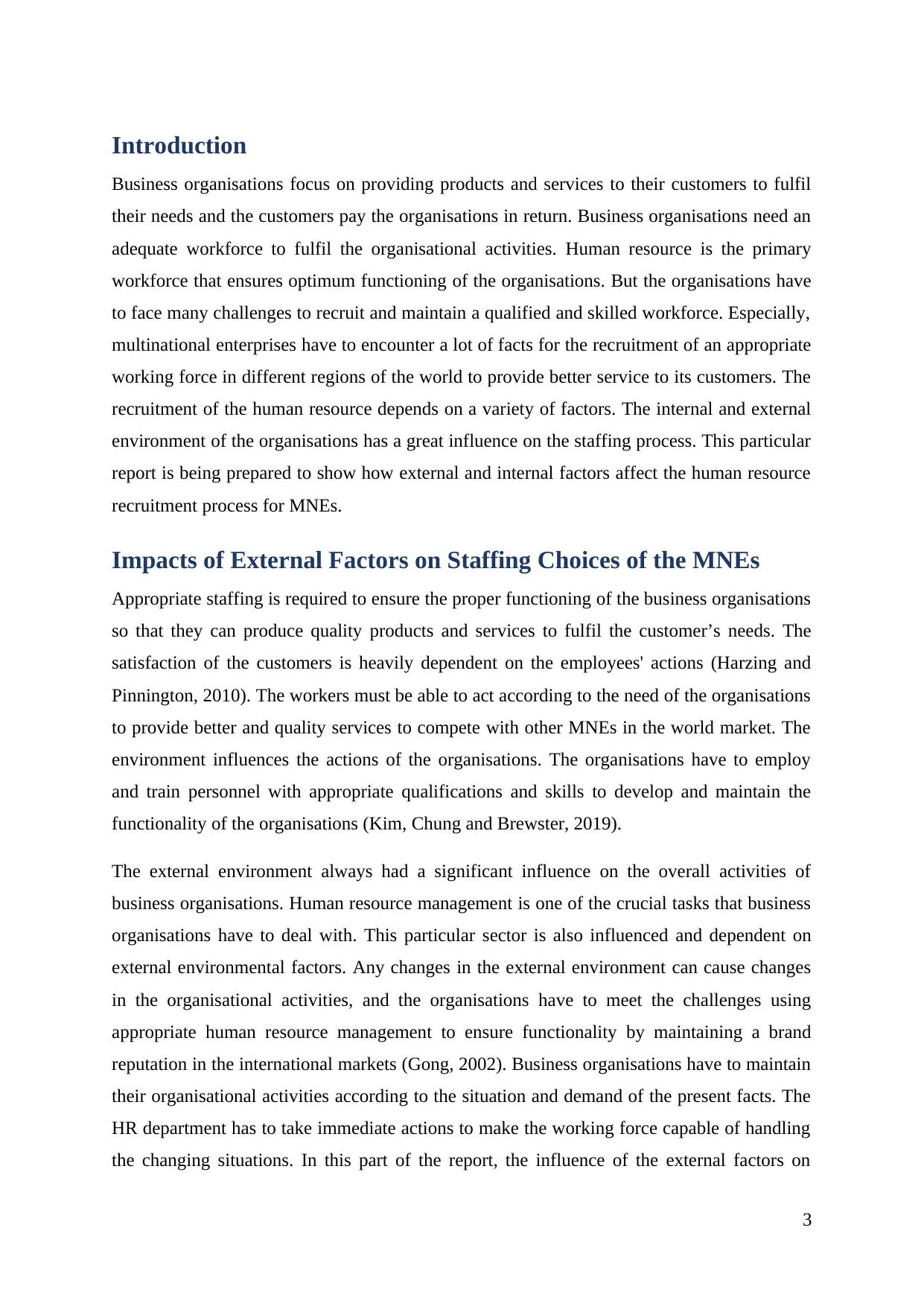
Introduction
Business organisations focus on providing products and services to their customers to fulfil
their needs and the customers pay the organisations in return. Business organisations need an
adequate workforce to fulfil the organisational activities. Human resource is the primary
workforce that ensures optimum functioning of the organisations. But the organisations have
to face many challenges to recruit and maintain a qualified and skilled workforce. Especially,
multinational enterprises have to encounter a lot of facts for the recruitment of an appropriate
working force in different regions of the world to provide better service to its customers. The
recruitment of the human resource depends on a variety of factors. The internal and external
environment of the organisations has a great influence on the staffing process. This particular
report is being prepared to show how external and internal factors affect the human resource
recruitment process for MNEs.
Impacts of External Factors on Staffing Choices of the MNEs
Appropriate staffing is required to ensure the proper functioning of the business organisations
so that they can produce quality products and services to fulfil the customer’s needs. The
satisfaction of the customers is heavily dependent on the employees' actions (Harzing and
Pinnington, 2010). The workers must be able to act according to the need of the organisations
to provide better and quality services to compete with other MNEs in the world market. The
environment influences the actions of the organisations. The organisations have to employ
and train personnel with appropriate qualifications and skills to develop and maintain the
functionality of the organisations (Kim, Chung and Brewster, 2019).
The external environment always had a significant influence on the overall activities of
business organisations. Human resource management is one of the crucial tasks that business
organisations have to deal with. This particular sector is also influenced and dependent on
external environmental factors. Any changes in the external environment can cause changes
in the organisational activities, and the organisations have to meet the challenges using
appropriate human resource management to ensure functionality by maintaining a brand
reputation in the international markets (Gong, 2002). Business organisations have to maintain
their organisational activities according to the situation and demand of the present facts. The
HR department has to take immediate actions to make the working force capable of handling
the changing situations. In this part of the report, the influence of the external factors on
3
Business organisations focus on providing products and services to their customers to fulfil
their needs and the customers pay the organisations in return. Business organisations need an
adequate workforce to fulfil the organisational activities. Human resource is the primary
workforce that ensures optimum functioning of the organisations. But the organisations have
to face many challenges to recruit and maintain a qualified and skilled workforce. Especially,
multinational enterprises have to encounter a lot of facts for the recruitment of an appropriate
working force in different regions of the world to provide better service to its customers. The
recruitment of the human resource depends on a variety of factors. The internal and external
environment of the organisations has a great influence on the staffing process. This particular
report is being prepared to show how external and internal factors affect the human resource
recruitment process for MNEs.
Impacts of External Factors on Staffing Choices of the MNEs
Appropriate staffing is required to ensure the proper functioning of the business organisations
so that they can produce quality products and services to fulfil the customer’s needs. The
satisfaction of the customers is heavily dependent on the employees' actions (Harzing and
Pinnington, 2010). The workers must be able to act according to the need of the organisations
to provide better and quality services to compete with other MNEs in the world market. The
environment influences the actions of the organisations. The organisations have to employ
and train personnel with appropriate qualifications and skills to develop and maintain the
functionality of the organisations (Kim, Chung and Brewster, 2019).
The external environment always had a significant influence on the overall activities of
business organisations. Human resource management is one of the crucial tasks that business
organisations have to deal with. This particular sector is also influenced and dependent on
external environmental factors. Any changes in the external environment can cause changes
in the organisational activities, and the organisations have to meet the challenges using
appropriate human resource management to ensure functionality by maintaining a brand
reputation in the international markets (Gong, 2002). Business organisations have to maintain
their organisational activities according to the situation and demand of the present facts. The
HR department has to take immediate actions to make the working force capable of handling
the changing situations. In this part of the report, the influence of the external factors on
3
⊘ This is a preview!⊘
Do you want full access?
Subscribe today to unlock all pages.

Trusted by 1+ million students worldwide
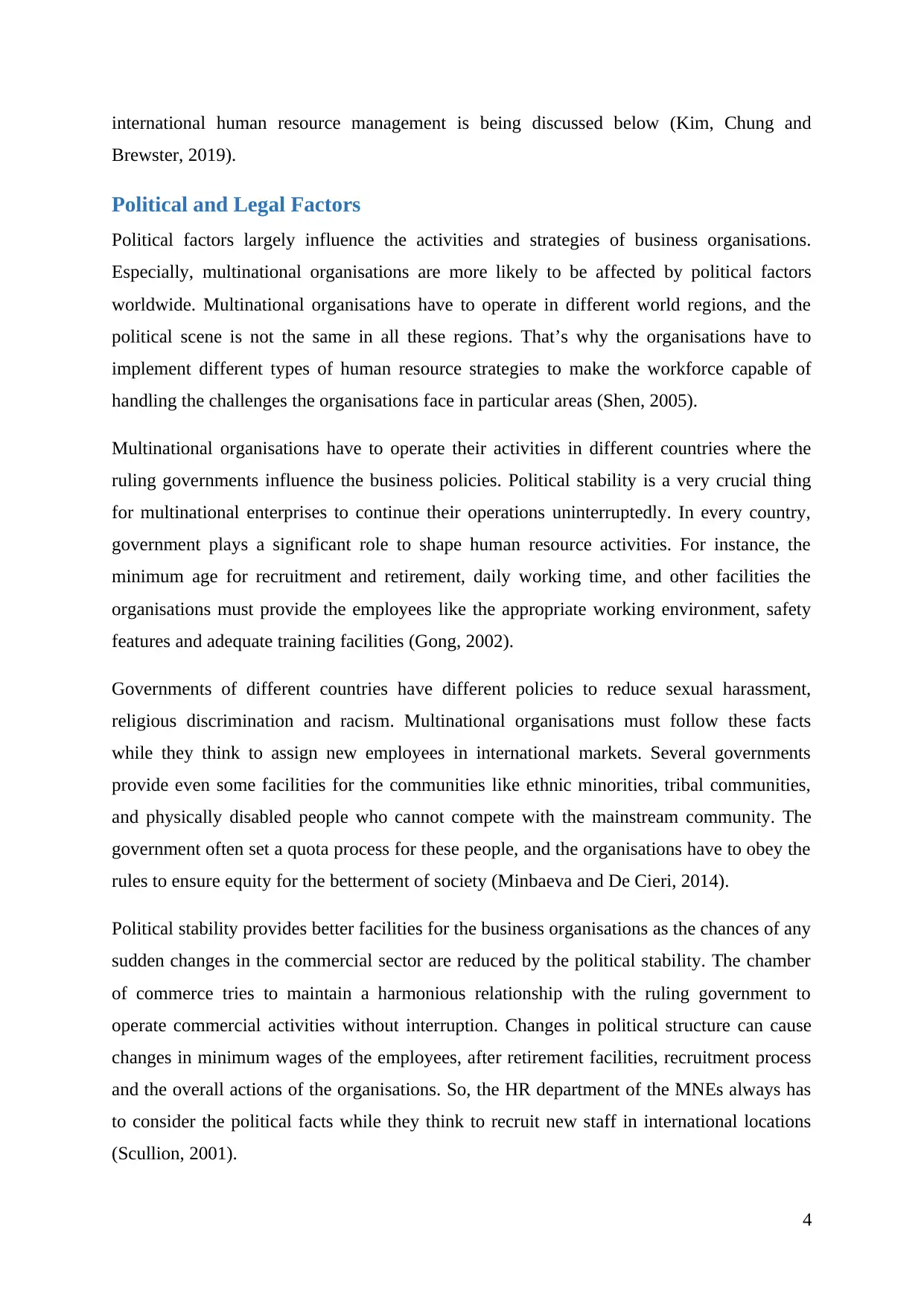
international human resource management is being discussed below (Kim, Chung and
Brewster, 2019).
Political and Legal Factors
Political factors largely influence the activities and strategies of business organisations.
Especially, multinational organisations are more likely to be affected by political factors
worldwide. Multinational organisations have to operate in different world regions, and the
political scene is not the same in all these regions. That’s why the organisations have to
implement different types of human resource strategies to make the workforce capable of
handling the challenges the organisations face in particular areas (Shen, 2005).
Multinational organisations have to operate their activities in different countries where the
ruling governments influence the business policies. Political stability is a very crucial thing
for multinational enterprises to continue their operations uninterruptedly. In every country,
government plays a significant role to shape human resource activities. For instance, the
minimum age for recruitment and retirement, daily working time, and other facilities the
organisations must provide the employees like the appropriate working environment, safety
features and adequate training facilities (Gong, 2002).
Governments of different countries have different policies to reduce sexual harassment,
religious discrimination and racism. Multinational organisations must follow these facts
while they think to assign new employees in international markets. Several governments
provide even some facilities for the communities like ethnic minorities, tribal communities,
and physically disabled people who cannot compete with the mainstream community. The
government often set a quota process for these people, and the organisations have to obey the
rules to ensure equity for the betterment of society (Minbaeva and De Cieri, 2014).
Political stability provides better facilities for the business organisations as the chances of any
sudden changes in the commercial sector are reduced by the political stability. The chamber
of commerce tries to maintain a harmonious relationship with the ruling government to
operate commercial activities without interruption. Changes in political structure can cause
changes in minimum wages of the employees, after retirement facilities, recruitment process
and the overall actions of the organisations. So, the HR department of the MNEs always has
to consider the political facts while they think to recruit new staff in international locations
(Scullion, 2001).
4
Brewster, 2019).
Political and Legal Factors
Political factors largely influence the activities and strategies of business organisations.
Especially, multinational organisations are more likely to be affected by political factors
worldwide. Multinational organisations have to operate in different world regions, and the
political scene is not the same in all these regions. That’s why the organisations have to
implement different types of human resource strategies to make the workforce capable of
handling the challenges the organisations face in particular areas (Shen, 2005).
Multinational organisations have to operate their activities in different countries where the
ruling governments influence the business policies. Political stability is a very crucial thing
for multinational enterprises to continue their operations uninterruptedly. In every country,
government plays a significant role to shape human resource activities. For instance, the
minimum age for recruitment and retirement, daily working time, and other facilities the
organisations must provide the employees like the appropriate working environment, safety
features and adequate training facilities (Gong, 2002).
Governments of different countries have different policies to reduce sexual harassment,
religious discrimination and racism. Multinational organisations must follow these facts
while they think to assign new employees in international markets. Several governments
provide even some facilities for the communities like ethnic minorities, tribal communities,
and physically disabled people who cannot compete with the mainstream community. The
government often set a quota process for these people, and the organisations have to obey the
rules to ensure equity for the betterment of society (Minbaeva and De Cieri, 2014).
Political stability provides better facilities for the business organisations as the chances of any
sudden changes in the commercial sector are reduced by the political stability. The chamber
of commerce tries to maintain a harmonious relationship with the ruling government to
operate commercial activities without interruption. Changes in political structure can cause
changes in minimum wages of the employees, after retirement facilities, recruitment process
and the overall actions of the organisations. So, the HR department of the MNEs always has
to consider the political facts while they think to recruit new staff in international locations
(Scullion, 2001).
4
Paraphrase This Document
Need a fresh take? Get an instant paraphrase of this document with our AI Paraphraser
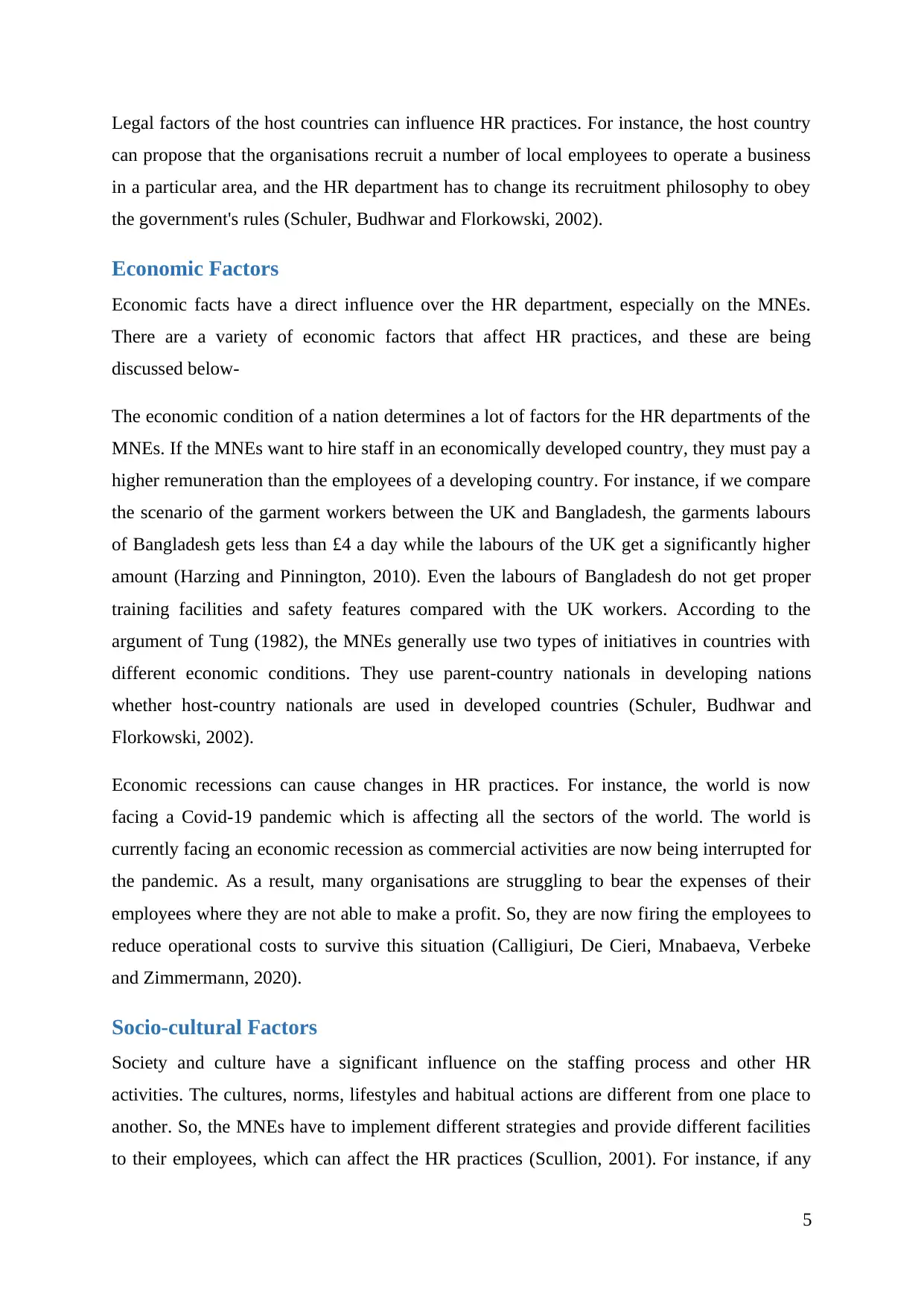
Legal factors of the host countries can influence HR practices. For instance, the host country
can propose that the organisations recruit a number of local employees to operate a business
in a particular area, and the HR department has to change its recruitment philosophy to obey
the government's rules (Schuler, Budhwar and Florkowski, 2002).
Economic Factors
Economic facts have a direct influence over the HR department, especially on the MNEs.
There are a variety of economic factors that affect HR practices, and these are being
discussed below-
The economic condition of a nation determines a lot of factors for the HR departments of the
MNEs. If the MNEs want to hire staff in an economically developed country, they must pay a
higher remuneration than the employees of a developing country. For instance, if we compare
the scenario of the garment workers between the UK and Bangladesh, the garments labours
of Bangladesh gets less than £4 a day while the labours of the UK get a significantly higher
amount (Harzing and Pinnington, 2010). Even the labours of Bangladesh do not get proper
training facilities and safety features compared with the UK workers. According to the
argument of Tung (1982), the MNEs generally use two types of initiatives in countries with
different economic conditions. They use parent-country nationals in developing nations
whether host-country nationals are used in developed countries (Schuler, Budhwar and
Florkowski, 2002).
Economic recessions can cause changes in HR practices. For instance, the world is now
facing a Covid-19 pandemic which is affecting all the sectors of the world. The world is
currently facing an economic recession as commercial activities are now being interrupted for
the pandemic. As a result, many organisations are struggling to bear the expenses of their
employees where they are not able to make a profit. So, they are now firing the employees to
reduce operational costs to survive this situation (Calligiuri, De Cieri, Mnabaeva, Verbeke
and Zimmermann, 2020).
Socio-cultural Factors
Society and culture have a significant influence on the staffing process and other HR
activities. The cultures, norms, lifestyles and habitual actions are different from one place to
another. So, the MNEs have to implement different strategies and provide different facilities
to their employees, which can affect the HR practices (Scullion, 2001). For instance, if any
5
can propose that the organisations recruit a number of local employees to operate a business
in a particular area, and the HR department has to change its recruitment philosophy to obey
the government's rules (Schuler, Budhwar and Florkowski, 2002).
Economic Factors
Economic facts have a direct influence over the HR department, especially on the MNEs.
There are a variety of economic factors that affect HR practices, and these are being
discussed below-
The economic condition of a nation determines a lot of factors for the HR departments of the
MNEs. If the MNEs want to hire staff in an economically developed country, they must pay a
higher remuneration than the employees of a developing country. For instance, if we compare
the scenario of the garment workers between the UK and Bangladesh, the garments labours
of Bangladesh gets less than £4 a day while the labours of the UK get a significantly higher
amount (Harzing and Pinnington, 2010). Even the labours of Bangladesh do not get proper
training facilities and safety features compared with the UK workers. According to the
argument of Tung (1982), the MNEs generally use two types of initiatives in countries with
different economic conditions. They use parent-country nationals in developing nations
whether host-country nationals are used in developed countries (Schuler, Budhwar and
Florkowski, 2002).
Economic recessions can cause changes in HR practices. For instance, the world is now
facing a Covid-19 pandemic which is affecting all the sectors of the world. The world is
currently facing an economic recession as commercial activities are now being interrupted for
the pandemic. As a result, many organisations are struggling to bear the expenses of their
employees where they are not able to make a profit. So, they are now firing the employees to
reduce operational costs to survive this situation (Calligiuri, De Cieri, Mnabaeva, Verbeke
and Zimmermann, 2020).
Socio-cultural Factors
Society and culture have a significant influence on the staffing process and other HR
activities. The cultures, norms, lifestyles and habitual actions are different from one place to
another. So, the MNEs have to implement different strategies and provide different facilities
to their employees, which can affect the HR practices (Scullion, 2001). For instance, if any
5
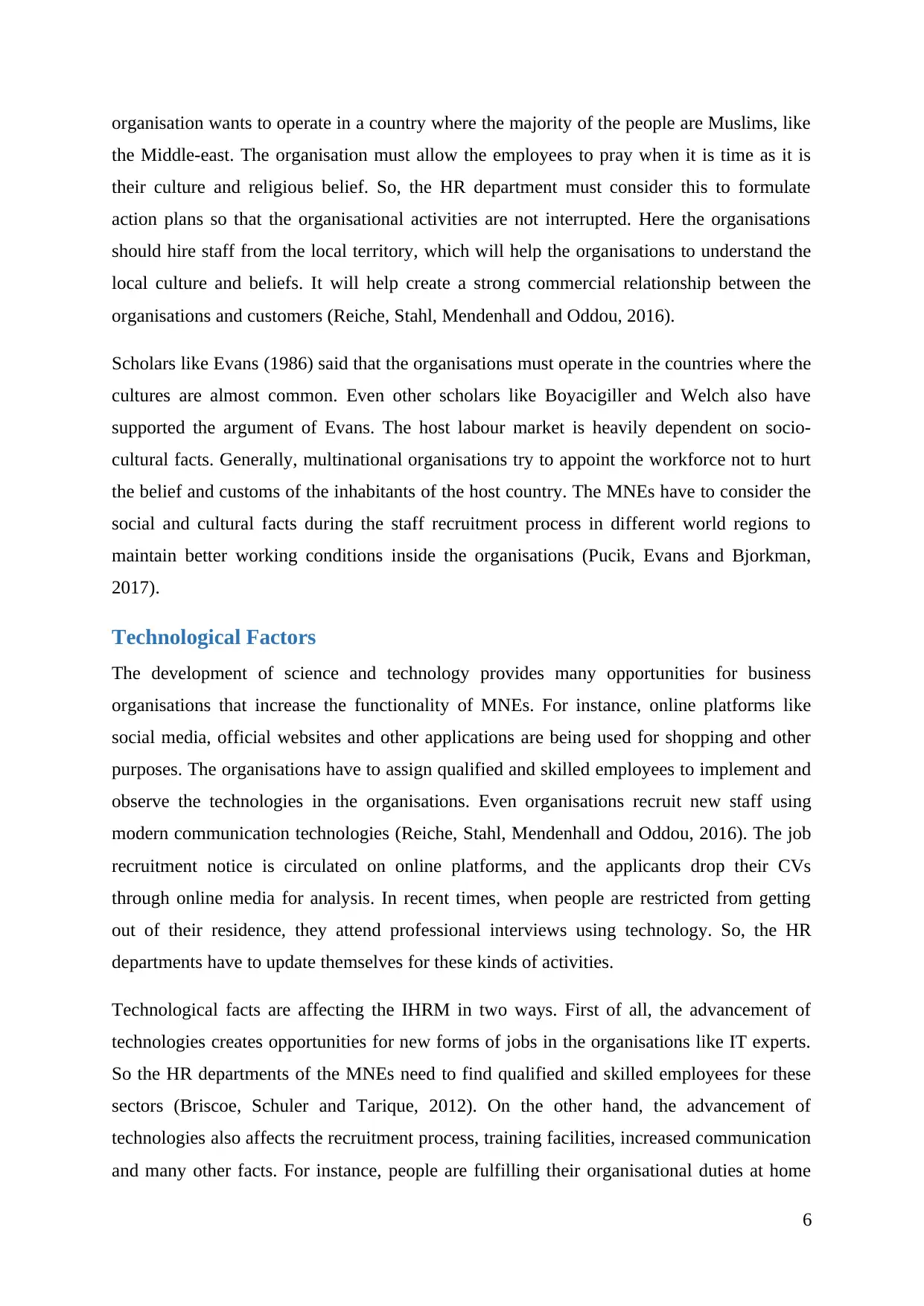
organisation wants to operate in a country where the majority of the people are Muslims, like
the Middle-east. The organisation must allow the employees to pray when it is time as it is
their culture and religious belief. So, the HR department must consider this to formulate
action plans so that the organisational activities are not interrupted. Here the organisations
should hire staff from the local territory, which will help the organisations to understand the
local culture and beliefs. It will help create a strong commercial relationship between the
organisations and customers (Reiche, Stahl, Mendenhall and Oddou, 2016).
Scholars like Evans (1986) said that the organisations must operate in the countries where the
cultures are almost common. Even other scholars like Boyacigiller and Welch also have
supported the argument of Evans. The host labour market is heavily dependent on socio-
cultural facts. Generally, multinational organisations try to appoint the workforce not to hurt
the belief and customs of the inhabitants of the host country. The MNEs have to consider the
social and cultural facts during the staff recruitment process in different world regions to
maintain better working conditions inside the organisations (Pucik, Evans and Bjorkman,
2017).
Technological Factors
The development of science and technology provides many opportunities for business
organisations that increase the functionality of MNEs. For instance, online platforms like
social media, official websites and other applications are being used for shopping and other
purposes. The organisations have to assign qualified and skilled employees to implement and
observe the technologies in the organisations. Even organisations recruit new staff using
modern communication technologies (Reiche, Stahl, Mendenhall and Oddou, 2016). The job
recruitment notice is circulated on online platforms, and the applicants drop their CVs
through online media for analysis. In recent times, when people are restricted from getting
out of their residence, they attend professional interviews using technology. So, the HR
departments have to update themselves for these kinds of activities.
Technological facts are affecting the IHRM in two ways. First of all, the advancement of
technologies creates opportunities for new forms of jobs in the organisations like IT experts.
So the HR departments of the MNEs need to find qualified and skilled employees for these
sectors (Briscoe, Schuler and Tarique, 2012). On the other hand, the advancement of
technologies also affects the recruitment process, training facilities, increased communication
and many other facts. For instance, people are fulfilling their organisational duties at home
6
the Middle-east. The organisation must allow the employees to pray when it is time as it is
their culture and religious belief. So, the HR department must consider this to formulate
action plans so that the organisational activities are not interrupted. Here the organisations
should hire staff from the local territory, which will help the organisations to understand the
local culture and beliefs. It will help create a strong commercial relationship between the
organisations and customers (Reiche, Stahl, Mendenhall and Oddou, 2016).
Scholars like Evans (1986) said that the organisations must operate in the countries where the
cultures are almost common. Even other scholars like Boyacigiller and Welch also have
supported the argument of Evans. The host labour market is heavily dependent on socio-
cultural facts. Generally, multinational organisations try to appoint the workforce not to hurt
the belief and customs of the inhabitants of the host country. The MNEs have to consider the
social and cultural facts during the staff recruitment process in different world regions to
maintain better working conditions inside the organisations (Pucik, Evans and Bjorkman,
2017).
Technological Factors
The development of science and technology provides many opportunities for business
organisations that increase the functionality of MNEs. For instance, online platforms like
social media, official websites and other applications are being used for shopping and other
purposes. The organisations have to assign qualified and skilled employees to implement and
observe the technologies in the organisations. Even organisations recruit new staff using
modern communication technologies (Reiche, Stahl, Mendenhall and Oddou, 2016). The job
recruitment notice is circulated on online platforms, and the applicants drop their CVs
through online media for analysis. In recent times, when people are restricted from getting
out of their residence, they attend professional interviews using technology. So, the HR
departments have to update themselves for these kinds of activities.
Technological facts are affecting the IHRM in two ways. First of all, the advancement of
technologies creates opportunities for new forms of jobs in the organisations like IT experts.
So the HR departments of the MNEs need to find qualified and skilled employees for these
sectors (Briscoe, Schuler and Tarique, 2012). On the other hand, the advancement of
technologies also affects the recruitment process, training facilities, increased communication
and many other facts. For instance, people are fulfilling their organisational duties at home
6
⊘ This is a preview!⊘
Do you want full access?
Subscribe today to unlock all pages.

Trusted by 1+ million students worldwide
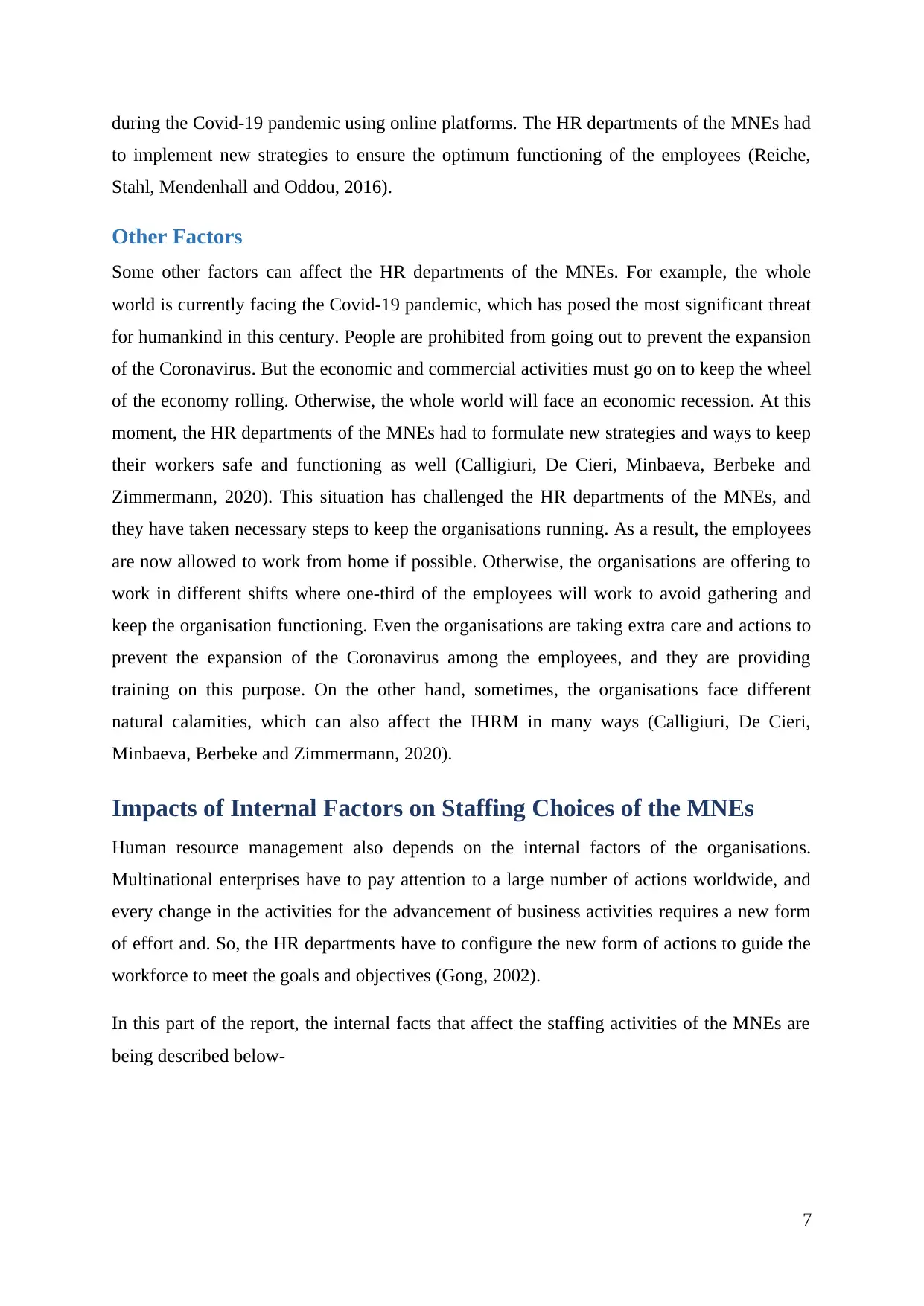
during the Covid-19 pandemic using online platforms. The HR departments of the MNEs had
to implement new strategies to ensure the optimum functioning of the employees (Reiche,
Stahl, Mendenhall and Oddou, 2016).
Other Factors
Some other factors can affect the HR departments of the MNEs. For example, the whole
world is currently facing the Covid-19 pandemic, which has posed the most significant threat
for humankind in this century. People are prohibited from going out to prevent the expansion
of the Coronavirus. But the economic and commercial activities must go on to keep the wheel
of the economy rolling. Otherwise, the whole world will face an economic recession. At this
moment, the HR departments of the MNEs had to formulate new strategies and ways to keep
their workers safe and functioning as well (Calligiuri, De Cieri, Minbaeva, Berbeke and
Zimmermann, 2020). This situation has challenged the HR departments of the MNEs, and
they have taken necessary steps to keep the organisations running. As a result, the employees
are now allowed to work from home if possible. Otherwise, the organisations are offering to
work in different shifts where one-third of the employees will work to avoid gathering and
keep the organisation functioning. Even the organisations are taking extra care and actions to
prevent the expansion of the Coronavirus among the employees, and they are providing
training on this purpose. On the other hand, sometimes, the organisations face different
natural calamities, which can also affect the IHRM in many ways (Calligiuri, De Cieri,
Minbaeva, Berbeke and Zimmermann, 2020).
Impacts of Internal Factors on Staffing Choices of the MNEs
Human resource management also depends on the internal factors of the organisations.
Multinational enterprises have to pay attention to a large number of actions worldwide, and
every change in the activities for the advancement of business activities requires a new form
of effort and. So, the HR departments have to configure the new form of actions to guide the
workforce to meet the goals and objectives (Gong, 2002).
In this part of the report, the internal facts that affect the staffing activities of the MNEs are
being described below-
7
to implement new strategies to ensure the optimum functioning of the employees (Reiche,
Stahl, Mendenhall and Oddou, 2016).
Other Factors
Some other factors can affect the HR departments of the MNEs. For example, the whole
world is currently facing the Covid-19 pandemic, which has posed the most significant threat
for humankind in this century. People are prohibited from going out to prevent the expansion
of the Coronavirus. But the economic and commercial activities must go on to keep the wheel
of the economy rolling. Otherwise, the whole world will face an economic recession. At this
moment, the HR departments of the MNEs had to formulate new strategies and ways to keep
their workers safe and functioning as well (Calligiuri, De Cieri, Minbaeva, Berbeke and
Zimmermann, 2020). This situation has challenged the HR departments of the MNEs, and
they have taken necessary steps to keep the organisations running. As a result, the employees
are now allowed to work from home if possible. Otherwise, the organisations are offering to
work in different shifts where one-third of the employees will work to avoid gathering and
keep the organisation functioning. Even the organisations are taking extra care and actions to
prevent the expansion of the Coronavirus among the employees, and they are providing
training on this purpose. On the other hand, sometimes, the organisations face different
natural calamities, which can also affect the IHRM in many ways (Calligiuri, De Cieri,
Minbaeva, Berbeke and Zimmermann, 2020).
Impacts of Internal Factors on Staffing Choices of the MNEs
Human resource management also depends on the internal factors of the organisations.
Multinational enterprises have to pay attention to a large number of actions worldwide, and
every change in the activities for the advancement of business activities requires a new form
of effort and. So, the HR departments have to configure the new form of actions to guide the
workforce to meet the goals and objectives (Gong, 2002).
In this part of the report, the internal facts that affect the staffing activities of the MNEs are
being described below-
7
Paraphrase This Document
Need a fresh take? Get an instant paraphrase of this document with our AI Paraphraser
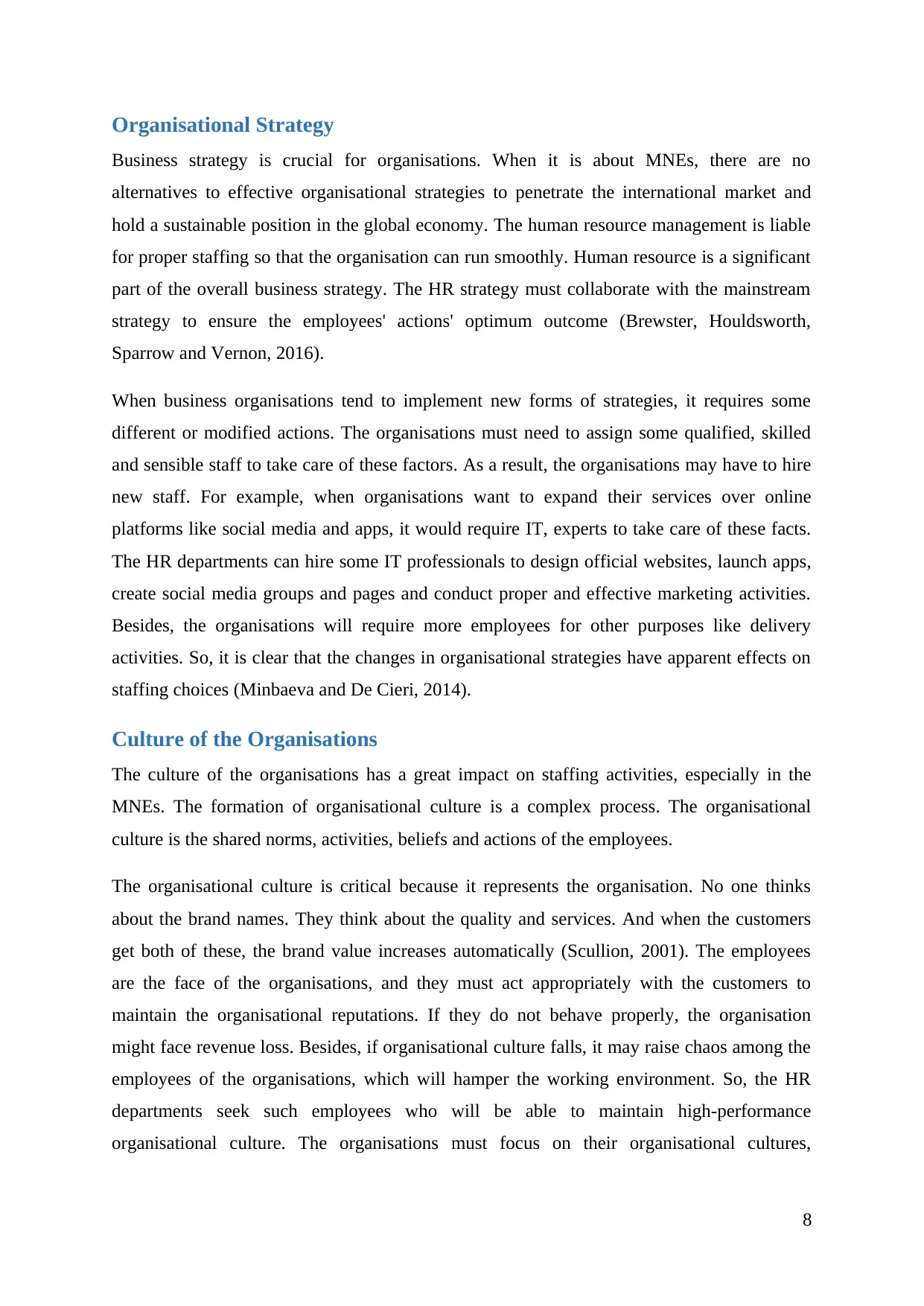
Organisational Strategy
Business strategy is crucial for organisations. When it is about MNEs, there are no
alternatives to effective organisational strategies to penetrate the international market and
hold a sustainable position in the global economy. The human resource management is liable
for proper staffing so that the organisation can run smoothly. Human resource is a significant
part of the overall business strategy. The HR strategy must collaborate with the mainstream
strategy to ensure the employees' actions' optimum outcome (Brewster, Houldsworth,
Sparrow and Vernon, 2016).
When business organisations tend to implement new forms of strategies, it requires some
different or modified actions. The organisations must need to assign some qualified, skilled
and sensible staff to take care of these factors. As a result, the organisations may have to hire
new staff. For example, when organisations want to expand their services over online
platforms like social media and apps, it would require IT, experts to take care of these facts.
The HR departments can hire some IT professionals to design official websites, launch apps,
create social media groups and pages and conduct proper and effective marketing activities.
Besides, the organisations will require more employees for other purposes like delivery
activities. So, it is clear that the changes in organisational strategies have apparent effects on
staffing choices (Minbaeva and De Cieri, 2014).
Culture of the Organisations
The culture of the organisations has a great impact on staffing activities, especially in the
MNEs. The formation of organisational culture is a complex process. The organisational
culture is the shared norms, activities, beliefs and actions of the employees.
The organisational culture is critical because it represents the organisation. No one thinks
about the brand names. They think about the quality and services. And when the customers
get both of these, the brand value increases automatically (Scullion, 2001). The employees
are the face of the organisations, and they must act appropriately with the customers to
maintain the organisational reputations. If they do not behave properly, the organisation
might face revenue loss. Besides, if organisational culture falls, it may raise chaos among the
employees of the organisations, which will hamper the working environment. So, the HR
departments seek such employees who will be able to maintain high-performance
organisational culture. The organisations must focus on their organisational cultures,
8
Business strategy is crucial for organisations. When it is about MNEs, there are no
alternatives to effective organisational strategies to penetrate the international market and
hold a sustainable position in the global economy. The human resource management is liable
for proper staffing so that the organisation can run smoothly. Human resource is a significant
part of the overall business strategy. The HR strategy must collaborate with the mainstream
strategy to ensure the employees' actions' optimum outcome (Brewster, Houldsworth,
Sparrow and Vernon, 2016).
When business organisations tend to implement new forms of strategies, it requires some
different or modified actions. The organisations must need to assign some qualified, skilled
and sensible staff to take care of these factors. As a result, the organisations may have to hire
new staff. For example, when organisations want to expand their services over online
platforms like social media and apps, it would require IT, experts to take care of these facts.
The HR departments can hire some IT professionals to design official websites, launch apps,
create social media groups and pages and conduct proper and effective marketing activities.
Besides, the organisations will require more employees for other purposes like delivery
activities. So, it is clear that the changes in organisational strategies have apparent effects on
staffing choices (Minbaeva and De Cieri, 2014).
Culture of the Organisations
The culture of the organisations has a great impact on staffing activities, especially in the
MNEs. The formation of organisational culture is a complex process. The organisational
culture is the shared norms, activities, beliefs and actions of the employees.
The organisational culture is critical because it represents the organisation. No one thinks
about the brand names. They think about the quality and services. And when the customers
get both of these, the brand value increases automatically (Scullion, 2001). The employees
are the face of the organisations, and they must act appropriately with the customers to
maintain the organisational reputations. If they do not behave properly, the organisation
might face revenue loss. Besides, if organisational culture falls, it may raise chaos among the
employees of the organisations, which will hamper the working environment. So, the HR
departments seek such employees who will be able to maintain high-performance
organisational culture. The organisations must focus on their organisational cultures,
8
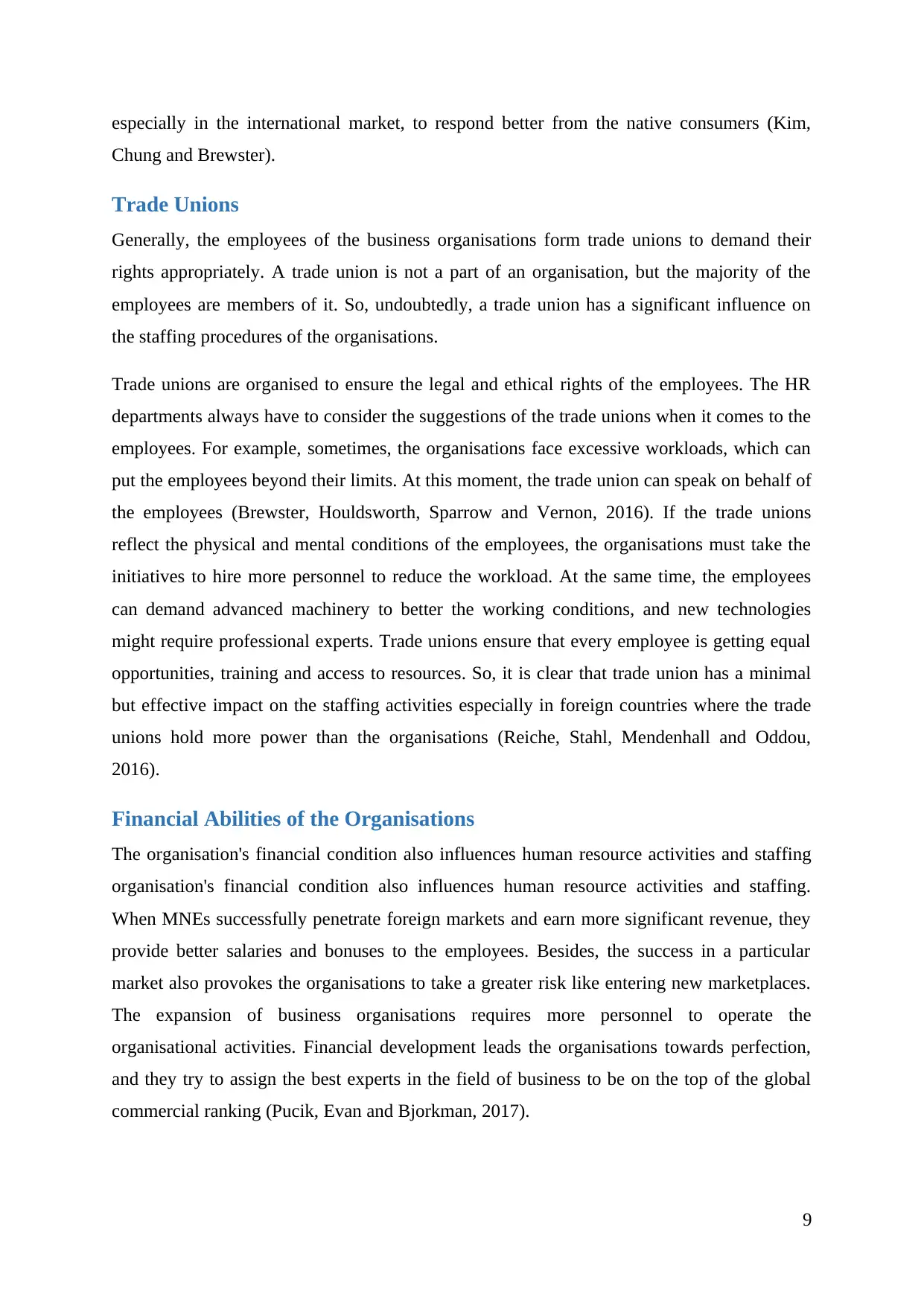
especially in the international market, to respond better from the native consumers (Kim,
Chung and Brewster).
Trade Unions
Generally, the employees of the business organisations form trade unions to demand their
rights appropriately. A trade union is not a part of an organisation, but the majority of the
employees are members of it. So, undoubtedly, a trade union has a significant influence on
the staffing procedures of the organisations.
Trade unions are organised to ensure the legal and ethical rights of the employees. The HR
departments always have to consider the suggestions of the trade unions when it comes to the
employees. For example, sometimes, the organisations face excessive workloads, which can
put the employees beyond their limits. At this moment, the trade union can speak on behalf of
the employees (Brewster, Houldsworth, Sparrow and Vernon, 2016). If the trade unions
reflect the physical and mental conditions of the employees, the organisations must take the
initiatives to hire more personnel to reduce the workload. At the same time, the employees
can demand advanced machinery to better the working conditions, and new technologies
might require professional experts. Trade unions ensure that every employee is getting equal
opportunities, training and access to resources. So, it is clear that trade union has a minimal
but effective impact on the staffing activities especially in foreign countries where the trade
unions hold more power than the organisations (Reiche, Stahl, Mendenhall and Oddou,
2016).
Financial Abilities of the Organisations
The organisation's financial condition also influences human resource activities and staffing
organisation's financial condition also influences human resource activities and staffing.
When MNEs successfully penetrate foreign markets and earn more significant revenue, they
provide better salaries and bonuses to the employees. Besides, the success in a particular
market also provokes the organisations to take a greater risk like entering new marketplaces.
The expansion of business organisations requires more personnel to operate the
organisational activities. Financial development leads the organisations towards perfection,
and they try to assign the best experts in the field of business to be on the top of the global
commercial ranking (Pucik, Evan and Bjorkman, 2017).
9
Chung and Brewster).
Trade Unions
Generally, the employees of the business organisations form trade unions to demand their
rights appropriately. A trade union is not a part of an organisation, but the majority of the
employees are members of it. So, undoubtedly, a trade union has a significant influence on
the staffing procedures of the organisations.
Trade unions are organised to ensure the legal and ethical rights of the employees. The HR
departments always have to consider the suggestions of the trade unions when it comes to the
employees. For example, sometimes, the organisations face excessive workloads, which can
put the employees beyond their limits. At this moment, the trade union can speak on behalf of
the employees (Brewster, Houldsworth, Sparrow and Vernon, 2016). If the trade unions
reflect the physical and mental conditions of the employees, the organisations must take the
initiatives to hire more personnel to reduce the workload. At the same time, the employees
can demand advanced machinery to better the working conditions, and new technologies
might require professional experts. Trade unions ensure that every employee is getting equal
opportunities, training and access to resources. So, it is clear that trade union has a minimal
but effective impact on the staffing activities especially in foreign countries where the trade
unions hold more power than the organisations (Reiche, Stahl, Mendenhall and Oddou,
2016).
Financial Abilities of the Organisations
The organisation's financial condition also influences human resource activities and staffing
organisation's financial condition also influences human resource activities and staffing.
When MNEs successfully penetrate foreign markets and earn more significant revenue, they
provide better salaries and bonuses to the employees. Besides, the success in a particular
market also provokes the organisations to take a greater risk like entering new marketplaces.
The expansion of business organisations requires more personnel to operate the
organisational activities. Financial development leads the organisations towards perfection,
and they try to assign the best experts in the field of business to be on the top of the global
commercial ranking (Pucik, Evan and Bjorkman, 2017).
9
⊘ This is a preview!⊘
Do you want full access?
Subscribe today to unlock all pages.

Trusted by 1+ million students worldwide
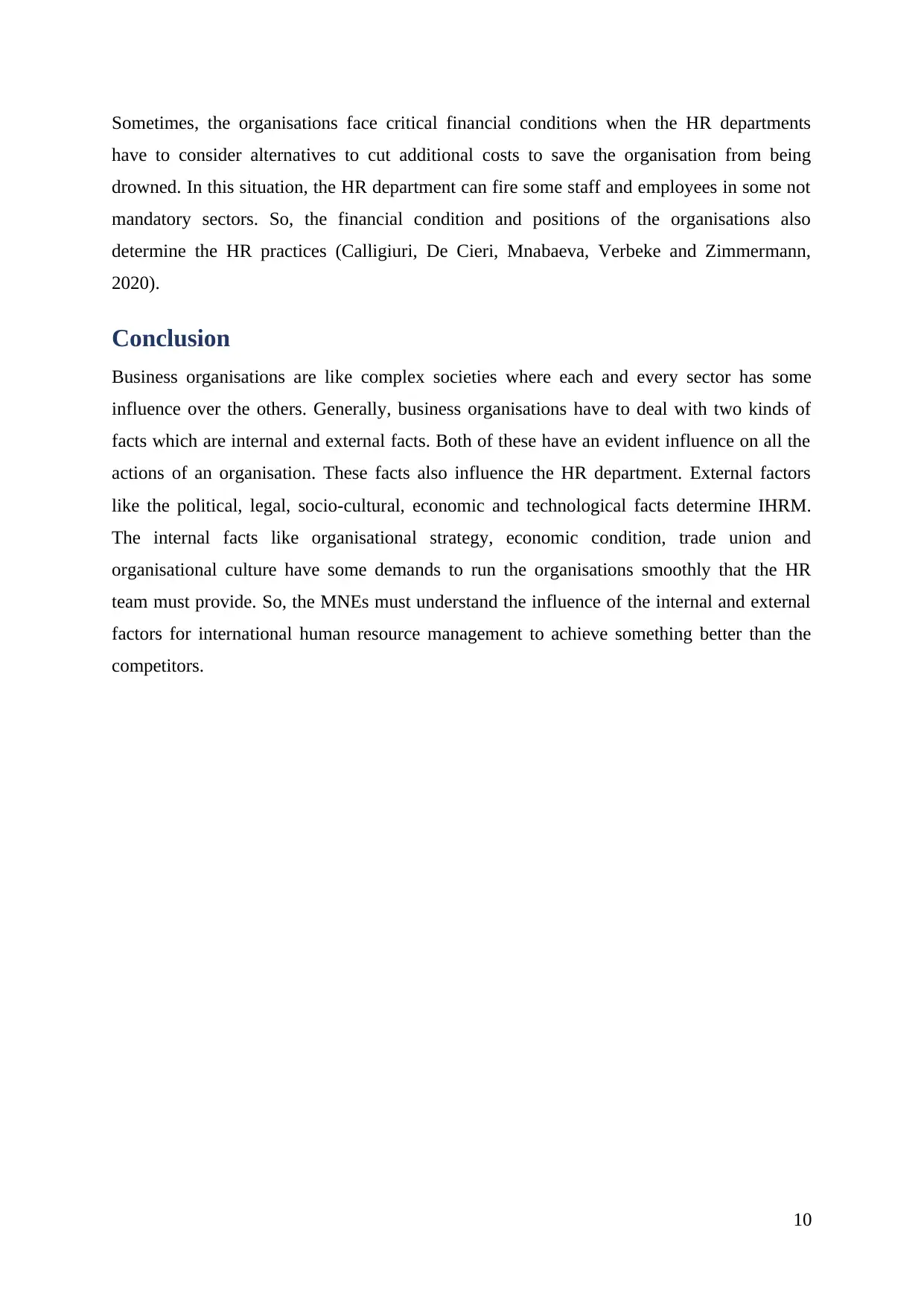
Sometimes, the organisations face critical financial conditions when the HR departments
have to consider alternatives to cut additional costs to save the organisation from being
drowned. In this situation, the HR department can fire some staff and employees in some not
mandatory sectors. So, the financial condition and positions of the organisations also
determine the HR practices (Calligiuri, De Cieri, Mnabaeva, Verbeke and Zimmermann,
2020).
Conclusion
Business organisations are like complex societies where each and every sector has some
influence over the others. Generally, business organisations have to deal with two kinds of
facts which are internal and external facts. Both of these have an evident influence on all the
actions of an organisation. These facts also influence the HR department. External factors
like the political, legal, socio-cultural, economic and technological facts determine IHRM.
The internal facts like organisational strategy, economic condition, trade union and
organisational culture have some demands to run the organisations smoothly that the HR
team must provide. So, the MNEs must understand the influence of the internal and external
factors for international human resource management to achieve something better than the
competitors.
10
have to consider alternatives to cut additional costs to save the organisation from being
drowned. In this situation, the HR department can fire some staff and employees in some not
mandatory sectors. So, the financial condition and positions of the organisations also
determine the HR practices (Calligiuri, De Cieri, Mnabaeva, Verbeke and Zimmermann,
2020).
Conclusion
Business organisations are like complex societies where each and every sector has some
influence over the others. Generally, business organisations have to deal with two kinds of
facts which are internal and external facts. Both of these have an evident influence on all the
actions of an organisation. These facts also influence the HR department. External factors
like the political, legal, socio-cultural, economic and technological facts determine IHRM.
The internal facts like organisational strategy, economic condition, trade union and
organisational culture have some demands to run the organisations smoothly that the HR
team must provide. So, the MNEs must understand the influence of the internal and external
factors for international human resource management to achieve something better than the
competitors.
10
Paraphrase This Document
Need a fresh take? Get an instant paraphrase of this document with our AI Paraphraser
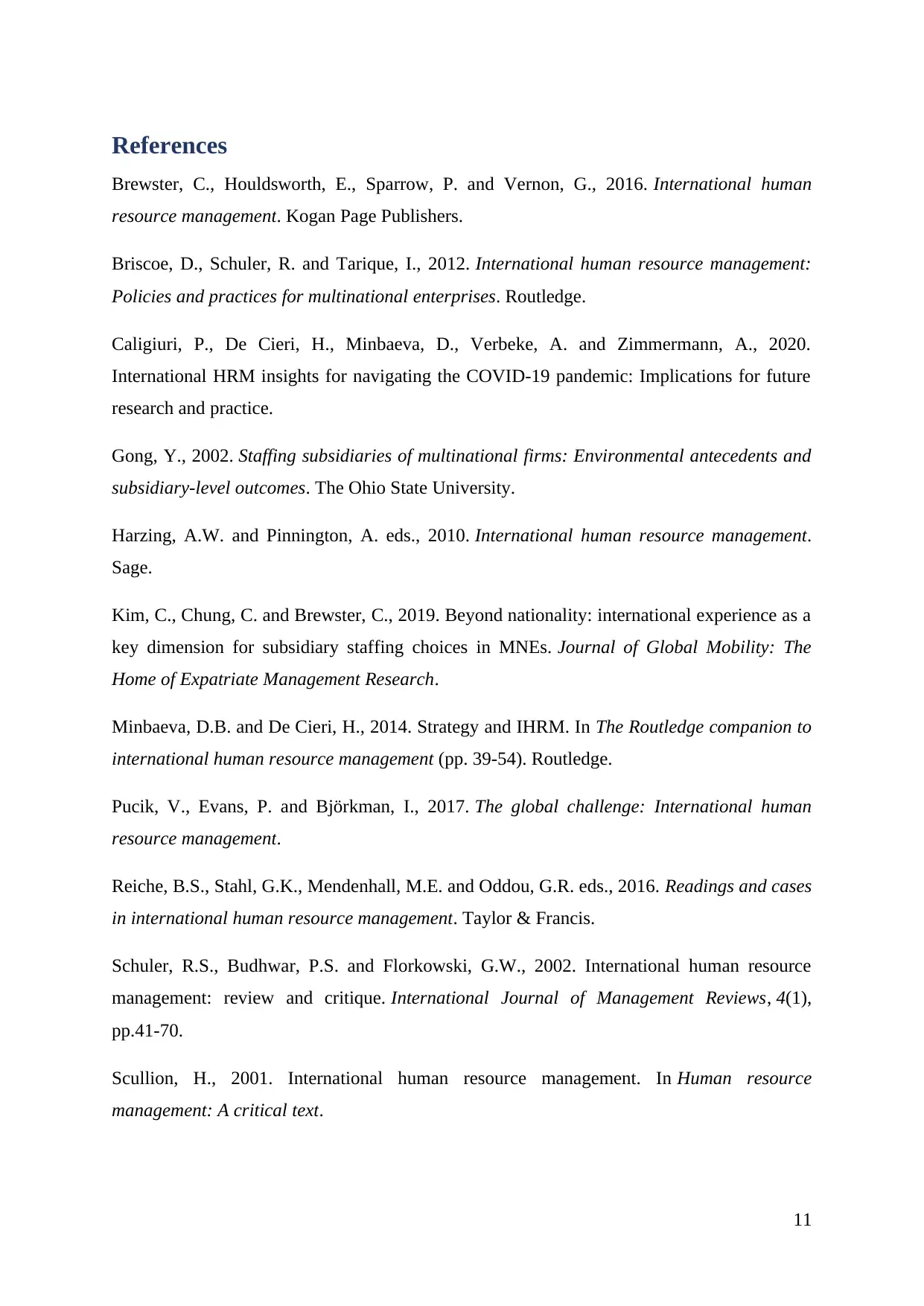
References
Brewster, C., Houldsworth, E., Sparrow, P. and Vernon, G., 2016. International human
resource management. Kogan Page Publishers.
Briscoe, D., Schuler, R. and Tarique, I., 2012. International human resource management:
Policies and practices for multinational enterprises. Routledge.
Caligiuri, P., De Cieri, H., Minbaeva, D., Verbeke, A. and Zimmermann, A., 2020.
International HRM insights for navigating the COVID-19 pandemic: Implications for future
research and practice.
Gong, Y., 2002. Staffing subsidiaries of multinational firms: Environmental antecedents and
subsidiary-level outcomes. The Ohio State University.
Harzing, A.W. and Pinnington, A. eds., 2010. International human resource management.
Sage.
Kim, C., Chung, C. and Brewster, C., 2019. Beyond nationality: international experience as a
key dimension for subsidiary staffing choices in MNEs. Journal of Global Mobility: The
Home of Expatriate Management Research.
Minbaeva, D.B. and De Cieri, H., 2014. Strategy and IHRM. In The Routledge companion to
international human resource management (pp. 39-54). Routledge.
Pucik, V., Evans, P. and Björkman, I., 2017. The global challenge: International human
resource management.
Reiche, B.S., Stahl, G.K., Mendenhall, M.E. and Oddou, G.R. eds., 2016. Readings and cases
in international human resource management. Taylor & Francis.
Schuler, R.S., Budhwar, P.S. and Florkowski, G.W., 2002. International human resource
management: review and critique. International Journal of Management Reviews, 4(1),
pp.41-70.
Scullion, H., 2001. International human resource management. In Human resource
management: A critical text.
11
Brewster, C., Houldsworth, E., Sparrow, P. and Vernon, G., 2016. International human
resource management. Kogan Page Publishers.
Briscoe, D., Schuler, R. and Tarique, I., 2012. International human resource management:
Policies and practices for multinational enterprises. Routledge.
Caligiuri, P., De Cieri, H., Minbaeva, D., Verbeke, A. and Zimmermann, A., 2020.
International HRM insights for navigating the COVID-19 pandemic: Implications for future
research and practice.
Gong, Y., 2002. Staffing subsidiaries of multinational firms: Environmental antecedents and
subsidiary-level outcomes. The Ohio State University.
Harzing, A.W. and Pinnington, A. eds., 2010. International human resource management.
Sage.
Kim, C., Chung, C. and Brewster, C., 2019. Beyond nationality: international experience as a
key dimension for subsidiary staffing choices in MNEs. Journal of Global Mobility: The
Home of Expatriate Management Research.
Minbaeva, D.B. and De Cieri, H., 2014. Strategy and IHRM. In The Routledge companion to
international human resource management (pp. 39-54). Routledge.
Pucik, V., Evans, P. and Björkman, I., 2017. The global challenge: International human
resource management.
Reiche, B.S., Stahl, G.K., Mendenhall, M.E. and Oddou, G.R. eds., 2016. Readings and cases
in international human resource management. Taylor & Francis.
Schuler, R.S., Budhwar, P.S. and Florkowski, G.W., 2002. International human resource
management: review and critique. International Journal of Management Reviews, 4(1),
pp.41-70.
Scullion, H., 2001. International human resource management. In Human resource
management: A critical text.
11
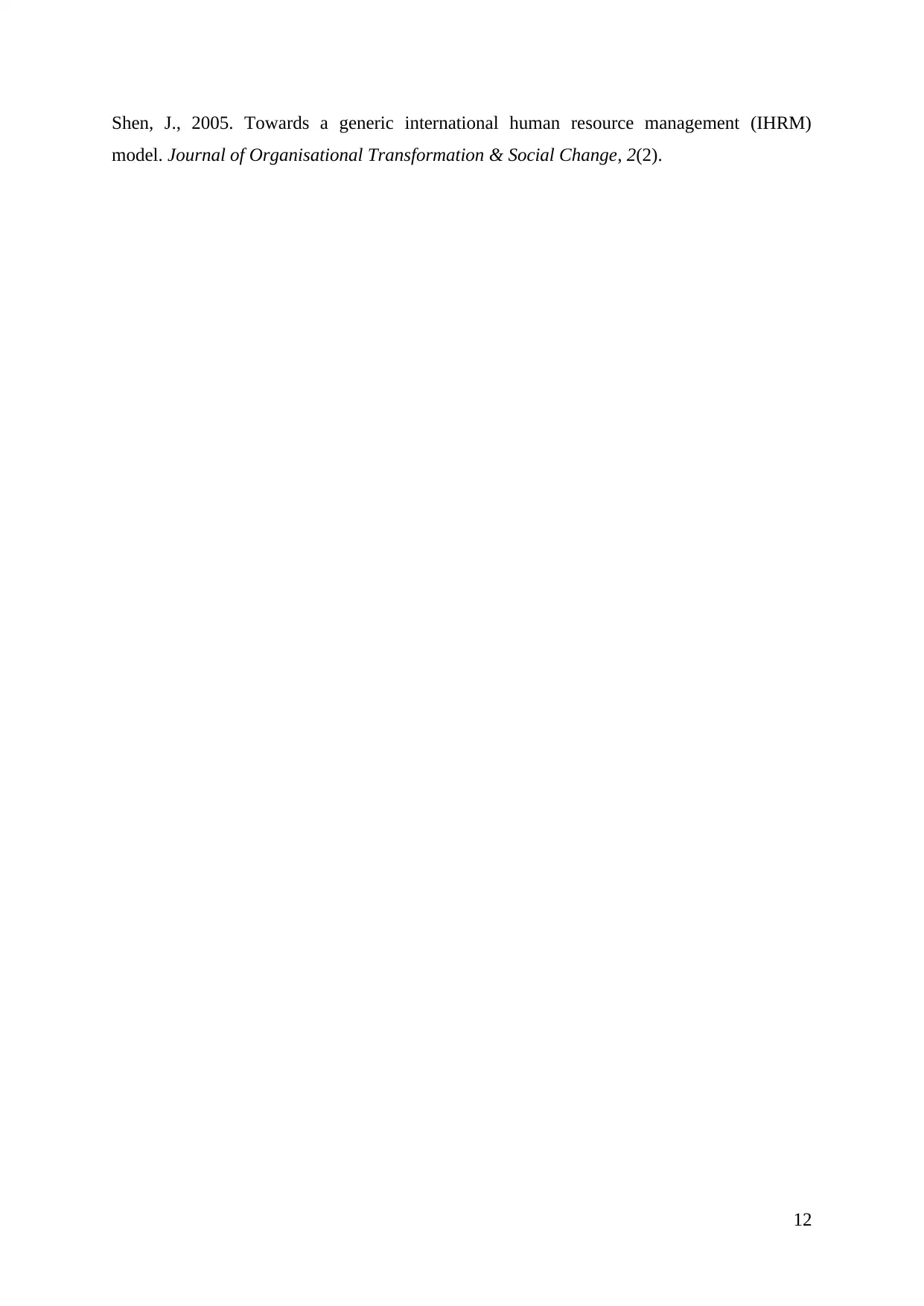
Shen, J., 2005. Towards a generic international human resource management (IHRM)
model. Journal of Organisational Transformation & Social Change, 2(2).
12
model. Journal of Organisational Transformation & Social Change, 2(2).
12
⊘ This is a preview!⊘
Do you want full access?
Subscribe today to unlock all pages.

Trusted by 1+ million students worldwide
1 out of 12
Related Documents
Your All-in-One AI-Powered Toolkit for Academic Success.
+13062052269
info@desklib.com
Available 24*7 on WhatsApp / Email
![[object Object]](/_next/static/media/star-bottom.7253800d.svg)
Unlock your academic potential
Copyright © 2020–2025 A2Z Services. All Rights Reserved. Developed and managed by ZUCOL.




